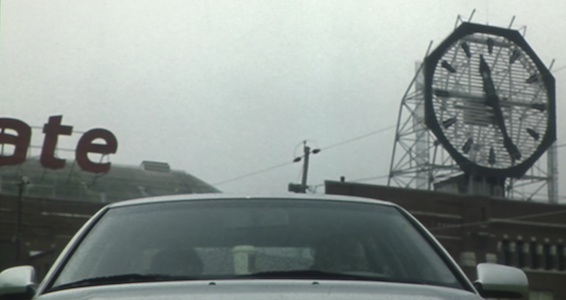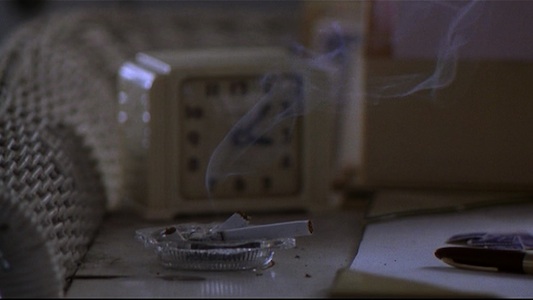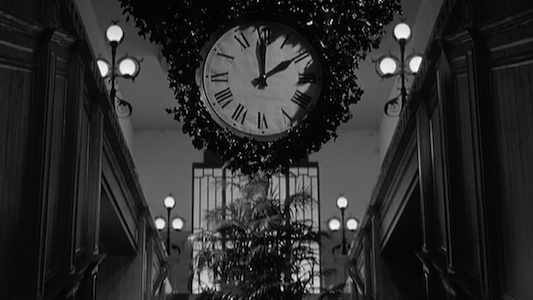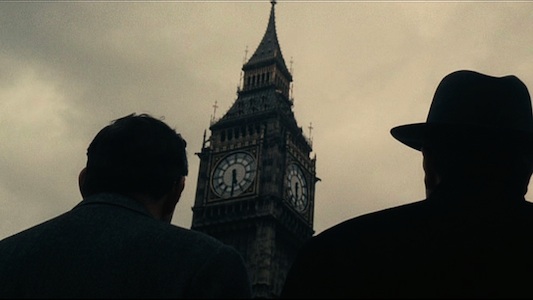
Three men press themselves into the shadows of a Manhattan garden apartment. The woman who lives there has returned unexpectedly, the clandestine intruders breathlessly watching as she makes her way down a short set of stairs through the living room to the kitchen, reaching out just above the sink to a clock affixed to the wall. This scene from 1967’s Wait Until Dark is further cut into more nail-biting fragments by Christian Marclay for his single-channel video installation The Clock (2010), a 24-hour-long assemblage of movie (and some TV) footage featuring the appearances, both starring and supporting, of timepieces. The suspense of the scene in the original Terence Young crime drama is built around two of the hidden men discovering that the woman (played by Audrey Hepburn) is blind. For The Clock, Marclay replaces that suspense for his own: where is the clock in the scene and what is the time.
Data stored in a hard-drive and controlled by a computer program, The Clock is synchronized with the actual timeframe during which it plays and comprises thousands of clips culled from cinema’s earliest days through today. Back in July, standing on the sweltering New York sidewalk outside the David Rubenstein Atrium waiting to see The Clock, I had a commonplace preoccupation with the time and was pleased to see volunteers managing the snaking queue, fielding questions about what we were about to experience and making projections about how long we could expect to wait. After learning I’d see the inside of the screening room in about two hours (I was lucky that day; the next time I got in line the prediction was five hours), I asked, “Is there a list of clips available?” Even as I asked, I realized any such list would be voluminous as an encyclopedia. None, I was told, is available.
The cinephile in me (some might say pedant) held out hope—a working list of some sort, the mother of all cinematic shot lists, must exist somewhere. Inside the darkened gallery as I watched, first, crook-necked from the floor at the base of the screen and then squashed, alongside three other spectators, in a small sofa with the back cushions removed, I knew, of course, the point was not to identify the clips. But I couldn’t help myself and, as snippets of films both familiar and unrecognized appeared, I continued to wish that my seat-mates were not strangers but rather my knowledgeable moviegoing friends willing to shout out the titles I couldn’t name.
Notwithstanding my impulse to treat The Clock as some sort of trivia game for ubernerds (one I would certainly lose), I found myself glued to my uncomfortable spot for reasons other than cataloguing film titles.
Reason One: Edge-of-your-seat Editing
A young boy navigates an underwater world in what looks like documentary or ephemeral footage. He comes across a large, menacing eel. He reaches out to it and, suddenly, a startling noise. I jump, expecting to see the boy’s stump of an arm, a languorous blood stain spreading under the sea. Instead, a door slams behind Stellan Skarsgård as he exits a glass-plated building in some blue-hued world. There’s in fact nothing to be scared of, nothing gruesome to witness. Even the trench coat-garbed Skarsgård, no doubt up to no good in the original movie, isn’t on the screen long enough to do harm. The split-second fright dissipates and The Clock ticks on.
Ever since Méliès stumbled upon the substitution edit for The Vanishing Lady (1897), a simple cut from one thing to another, and its endless refinements, have provided more than a century of movie magic. Marclay makes use of these classic editing techniques to mash together scenes with otherwise tenuous connections, demonstrating a mastery of continuity. A man opens a door to enter a room, a woman leaves another room through a different door in another cinematic world. Sounds from one scene are overlaid on the next scene from a different movie, constantly subverting expectations. Not only does the eel not bite the hand, but there is no hand, no aquatic boy, no longer any eel. Technicolor jump cuts to grainy black-and-white. Twenty-four frames per second crashes against 18. Widescreen squished next to 4X3. Poor reproduction quality right up against the pristine. Among all the variations, some connective tissue can always be identified: motion, sound, circumstance: the slamming sound (be it eel jaws or door jambs), blue water replaced by the blue gleam of a sky reflected in office-building windows. In The Clock, Marclay wields the tools of narrative cinema much more effectively than in any story film I’ve seen in a long while.

Before you can even identify the technique used—never mind the actors, films, scenes, decades,—Marclay is on to the next, and the next. The point is quickly grasped—time marches on. Still, the masterful editing keeps the viewer in thrall, waiting for some suspenseful moment to be resolved in the usual way: “The woman we are ripping off is blind!” “Will the boy escape the eel at the last minute or lose his hand?” But there is no story. Nothing is resolved, no climax, no denouement, no plotline, no payoff of any kind. The doors lead to a nowhere where nothing ever happens. The only narrative satisfaction that could possibly be derived is, oh, there’s the clock and that is the time. Yet, for a bit longer than the duration of the latest Bond film, I sat transfixed. (Editors take note.)
While time nor Marclay stand still, he crafts some extended cinema moments, changing up the rhythm of merely marking time (yes, yes, much in the way we perceive time as elastic, stretching on with boredom or pain, accelerating during the good times). In addition to Wait Until Dark—incidentally by the director of the first James Bond film, Dr. No—I am treated to another Audrey Hepburn film when the party scene from Breakfast at Tiffany’s (1961, Blake Edwards) makes a compressed appearance. Marclay keeps the soundtrack in tact—the groovy Mancini music, as well as the conversations and tinkling cocktail party noise—as the camera bobs around the swells and bohemians as in the original. He also uses the watch wrapped around one partygoer’s ankle as a punchline, much in the same way Blake Edwards does in the film.
Reason Two: The Joy of the Familiar
The strong hope of seeing something familiar, possibly beloved, makes it even more difficult to leave. A clip from something that looks like Paul Fejos’s Lonesome has me trying to spot the silents among the clips. What time does the clock say in Safety Last!? I try to figure it out based on the physics of Harold Lloyd dangling from the minute hand, possibly missing the actual appearance of the clip (2:45 pm according to one still from the film). During my second session (around 11:00 am to sometime after 1:30 pm), Broadway Danny Rose strides down 7th Avenue, past a black-and-white Carnegie Deli to a hotdog cart, in a relatively lengthy sequence rendered surreal as it is stripped of the familiar neurotic patter and American Song Book selections omnipresent in a Woody Allen movie. Another New York foodcart quickly replaces it, this one in color. It could be a good time to leave, on a high note. But somehow I don’t. To my delight, I’m rewarded a few clips later, when a younger, longer-haired Woody Allen makes his way up the same stretch of 7th Avenue.

Amid all my attempts to memorize clips and transitions, try to recall a title, my mind does occasionally wander. Is that the best quality clip available? Oh, dear, is that film in danger? How timeless will The Clock prove to be? Will the technology exist in 50 years for it even to be shown? I wonder if the intermittent blinking of tiny blue screens is the audience making sure The Clock synchs with real time—it does, with some minuscule warps—or, more disturbingly, actually checking the time. (As one friend frustratingly exclaimed after another friend could not say when she had left the installation: “There was a big clock on the wall!”) I also wonder if I’m wasting my time, the point having been driven home long ago about elasticity, implacability, tyranny of time. I have more to do today. I really should get up and go. And then, what will I be missing when I do?
I have a split-second epiphany that my fixation to name film titles and remember how the clips are linked might be my way of trying to turn back The Clock, of releasing Marclay’s hold on me, a desire to control time itself. I try to let it go. The next bit recaptures my attention, a huge clock in a black-and-white conference room somewhere in 1970s Asia (late 1960s?), and I’m once again ticking off the minutes to Marclay’s cinematic time.

Even all these months later, I occasionally search the Web for a wiki, dedicated denizens compiling, then verifying, a shot list. Hoping to jar my memory about the clips I saw, perhaps correcting misremembered moments—Was that really an aquatic boy or was it a girl? What time was the Breakfast at Tiffany’s cocktail party? Did I see that in my first session of my second? Can I be mistaking Broadway Danny Rose for some other Woody Allen character on 7th Avenue? I scan the first two pages of Google’s results and then think, what a waste of time.
Note: MoMA is giving New Yorkers (and travelers willing to go the distance) another chance to watch The Clock. Over the end-of-year holidays, a 130-seat theater will be filled and refilled over the course of a month, when visitors can watch as little or as much as they want during regular museum hours. The entire 24-hour video screens New Year’s Eve and three subsequent weekends in January.




